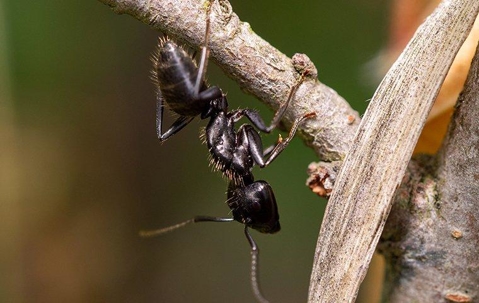Ants are annoying pests. They get into your food. They climb around on your kitchen counters, and they create superhighways on your kitchen floor. It is no fun when ants get into your home, especially if the ants that get into your home are carpenter ants. Carpenter ants are a double threat. They have the ability to be annoying, but they also damage the wood of your home while they're doing it. Here is a quick guide to help you get control of carpenter ant issues, starting from the inside and working our way out.
1. Protect Your Food
When a carpenter ant, or two, gets into your home, it is important that they don't find an accessible food source. This can inspire them to create a nest within the walls of your home. While they can create a nest even if an interior food source is not present, you increase the risk by feeding those ants.
- Put packaged food inside sealed containers.
- Remove kitchen trash routinely and keep the receptacle clean.
- Put dirty dishes in a sink full of water if they will be sitting overnight
- Put pet food down only during meal times.
- Put fruit in the fridge.
- Vacuum and clean floors routinely.
- Clean pantry shelves of any food debris.
2. Seal Access Points
When carpenter ants get into your home, you can deter them from finding what they're looking for by blocking off access routes. While you can't completely seal every pathway, the reduction of pathways is known to have a big impact on carpenter ant activity and nest establishment.
- Make sure you have a good seal around the pipe that comes in under your kitchen sink.
- Seal around windows in your kitchen.
- Seal gaps, cracks, and holes in walls and baseboards in your kitchen and pantry.
3. Address Interior Moisture And Humidity
Carpenter ants are moisture pests. They will be drawn to every area in your home that is high in humidity. When you take steps to reduce humidity and address moisture points, you can make your home less inviting. This will have an impact on more than just carpenter ants, so it is well worth the effort.
- Fix leaky faucets.
- Fix weeping pipes.
- Install fans or dehumidifiers in humid locations.
4. Seal Entry Points
When carpenter ants explore your walls, it is important that you make it difficult for them to find a way inside. Every available entry point will increase the risk of nest creation.
- Seal gaps, cracks, and holes.
- Fix damaged screens.
- Address gaps in weatherstripping or door sweeps.
5. Reduce Perimeter Moisture
Moisture attracts carpenter ants to the exterior of a home. They look for wood that has been decayed by the influence of moisture. They feed on moisture pests. And one of the dietary staples of a carpenter ant is honeydew. This is created by aphids and other plant-damaging pests, which are drawn to moist, decaying vegetation.
- Clean gutters.
- Repair broken splash blocks and downspouts.
- Trim tree canopy as needed.
- Water plants in the morning.
6. Remove Attractants
If you have stumps, logs, a tree with heart rot, an old fence, a rotting deck, or some other desirable harborage option, carpenter ants will establish nests in your yard. These yard nests will act as staging areas for these ants to get into your Plano property.
Get Help
If you live in Plano, or somewhere else in our North Texas service area, let the team at Adams Exterminating help you address carpenter ant issues and other pest problems that arise. We use advanced technologies and methods to get you the results you're looking for. Contact us today and get the right solution for your pest problem.

